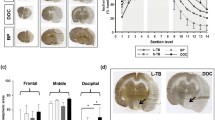Abstract
The intraluminal filament procedure is the most common model of middle cerebral artery occlusion (MCAO). However, consequences of subtle variations in surgical technique on behavioral outcome measures have not been sufficiently explored, which is the aim of this study. Rats randomly received one of three types of transient MCAO (60 min) surgeries. The first transected the external carotid artery (ECA) for filament insertion. The other two inserted the filament in the carotid artery (CA), and after reperfusion, the CA was either ligated or blood flow restored. All animals, including shams and naïve controls, were monitored with behavioral tests for 90 days. Lesion size and NeuN + cells in the striatum were comparable among MCAO groups. However, rats with ECA transection were consistently lighter than rats with permanent CA ligation, which were lighter than rats with CA reperfusion. Furthermore, rats with ECA transection exhibited the poorest lick efficiency and the greatest impairments in sensorimotor tasks. This study is the first to systematically evaluate the role of ECA transection on functional and morbidity outcomes. Behavioral impairments attributable to the surgical procedure were observed. This confounds studies and is an important issue that needs to be considered when using the intraluminal filament model.






Similar content being viewed by others
References
Hossmann KA. Cerebral ischemia: models, methods and outcomes. Neuropharmacology. 2008;55(3):257–70.
Koizumi J, Yoshida Y, Nakazawa T, Ohneda G. Experimental studies of ischemic brain edema, I: a new experimental model of cerebral embolism in rats in which recirculation can be introduced in the ischemic area. Jpn J Stroke. 1986;8:1–8.
Longa EZ, Weinstein PR, Carlson S, Cummins R. Reversible middle cerebral artery occlusion without craniectomy in rats. Stroke. 1989;20(1):84–91.
Paxinos G. The rat nervous system. 2nd ed. San Diego: Academic Press; 1995.
Dittmar M, Spruss T, Schuierer G, Horn M. External carotid artery territory ischemia impairs outcome in the endovascular filament model of middle cerebral artery occlusion in rats. Stroke. 2003;34(9):2252–7.
Dittmar MS, Vatankhah B, Fehm NP, Retzl G, Schuierer G, Bogdahn U, et al. The role of ECA transection in the development of masticatory lesions in the MCAO filament model. Exp Neurol. 2005;195(2):372–8.
Boyko M, Zlotnik A, Gruenbaum BF, Gruenbaum SE, Ohayon S, Goldsmith T, et al. An experimental model of focal ischemia using an internal carotid artery approach. J Neurosci Methods. 2010;193:246–53.
Gerriets T, Stolz E, Walberer M, Muller C, Kluge A, Bachmann A, et al. Noninvasive quantification of brain edema and the space-occupying effect in rat stroke models using magnetic resonance imaging. Stroke. 2004;35(2):566–71.
Modo M, Stroemer RP, Tang E, Veizovic T, Sowniski P, Hodges H. Neurological sequelae and long-term behavioural assessment of rats with transient middle cerebral artery occlusion. J Neurosci Methods. 2000;104(1):99–109.
Ungerstedt U, Arbuthnott GW. Quantitative recording of rotational behavior in rats after 6-hydroxy-dopamine lesions of the nigrostriatal dopamine system. Brain Res. 1970;24(3):485–93.
Barth TM, Jones TA, Schallert T. Functional subdivisions of the rat somatic sensorimotor cortex. Behav Brain Res. 1990;39(1):73–95.
Bland ST, Schallert T, Strong R, Aronowski J, Grotta JC, Feeney DM. Early exclusive use of the affected forelimb after moderate transient focal ischemia in rats: functional and anatomic outcome. Stroke. 2000;31(5):1144–52.
Schallert T, Hall S. ‘Disengage’ sensorimotor deficit following apparent recovery from unilateral dopamine depletion. Behav Brain Res. 1988;30(1):15–24.
Dwyer DM. Microstructural analysis of conditioned and unconditioned responses to maltodextrin. Learn Behav. 2008;36(2):149–58.
Montoya CP, Campbell-Hope LJ, Pemberton KD, Dunnett SB. The “staircase test”: a measure of independent forelimb reaching and grasping abilities in rats. J Neurosci Methods. 1991;36(2–3):219–28.
Kelly CM, Precious SV, Penketh R, Amso N, Dunnett SB, Rosser AE. Striatal graft projections are influenced by donor cell type and not the immunogenic background. Brain. 2007;130(Pt 5):1317–29.
Bodine-Fowler S. Skeletal muscle regeneration after injury: an overview. J Voice. 1994;8(1):53–62.
Acknowledgements
The authors thank Jane Heath and Derek Scarbrough for assistance with the histology, and Stephen Paisey, Pawel Tokarczuk and Andrew Stewart for assistance with the MRI. This work was supported by grants from the European Union FP6 program (LSHB-CT-2006-037526, StemStroke), an Alexander von Humboldt Research Fellowship to TDF, and an International Collaboration Award (Cardiff University) to RCT.
Author information
Authors and Affiliations
Corresponding author
Rights and permissions
About this article
Cite this article
Trueman, R.C., Harrison, D.J., Dwyer, D.M. et al. A Critical Re-Examination of the Intraluminal Filament MCAO Model: Impact of External Carotid Artery Transection. Transl. Stroke Res. 2, 651–661 (2011). https://doi.org/10.1007/s12975-011-0102-4
Received:
Revised:
Accepted:
Published:
Issue Date:
DOI: https://doi.org/10.1007/s12975-011-0102-4



